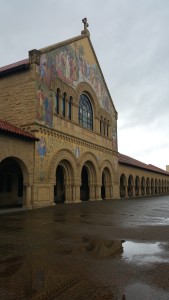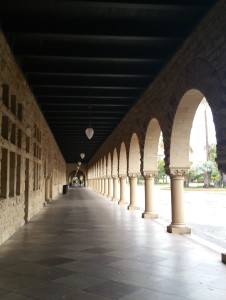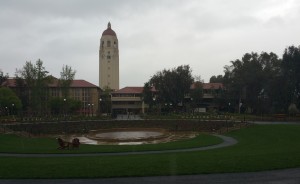 A couple of weeks ago, at the tail end of a quick trip out to the San Joaquin Valley to attend to some family business, I took a detour on my way back to SFO. After I crossed the San Mateo bridge, I headed south and went to Stanford.
A couple of weeks ago, at the tail end of a quick trip out to the San Joaquin Valley to attend to some family business, I took a detour on my way back to SFO. After I crossed the San Mateo bridge, I headed south and went to Stanford.
A steady rain was falling — not so heavy that I needed an umbrella, but heavy enough that I could have used one. But rain has always struck me as a benediction, and this is especially the case now for drought-stricken California, so I was doubly glad to let that rain fall on me.
At 9:30 on that rainy Saturday morning, the campus was all but deserted. There were a few tourists snapping pictures. I guess I was a tourist too, though I never feel like one when I go to back to Stanford. But I also never feel like I belong there — I mostly just wonder at the fact that I once did. It is all now very like a dream.
The campus is beautiful any time — in summer and winter, in sunshine or rain. But rain always brings out one of the often hidden aspects of Stanford’s beauty: the sweet, fresh, faintly spicy fragrances of its edenic mediterranean landscaping. In the rain, the whole campus turns into a perfumed garden of paradise.
At the same time, if you walk beneath the arcades around the quad on rainy days, you can catch a whiff of the faint but not-unpleasing musty note offered by whatever aged timbers yet remain from the original construction. This is the fragrance of groves and gardens long ago laid waste to hold aloft the red-tiled roof that has sheltered generations of students and professors from the scant but welcome rain.
 As long as this university stands (and I hope that’s a good long time), the inner quad will remain as it is, even if that means rebuilding it after yet another earthquake. But may heaven forbid such a disaster!
As long as this university stands (and I hope that’s a good long time), the inner quad will remain as it is, even if that means rebuilding it after yet another earthquake. But may heaven forbid such a disaster!
Alas, heaven does not seem to be in the habit of forbidding disasters, major or minor. Nothing lasts forever, nothing gold can stay. I guess that’s just as well — or we find ways to make it well. We hold out hope that even out of destruction, out of loss, may emerge new beauties, new symmetries, new relationships of the parts of life to the whole.
I saw this process, or the the potential for it, during my recent visit to Stanford. There is a new open space on the campus — new to me, anyhow. In the spot where Meyer Library once stood there is now a beautiful expanse of emerald lawn. Meyer was the undergraduate library where, circa 1986, students could go to the cutting-edge computer lab and use one of a few dozen Macintoshes to complete their Intro to CompSci homework, writing programs for Karel the Robot. The edges of the library’s former quadrilateral footprint, square as the steps on Karel’s grid, have been smoothed and softened, rounded and sloped, and in the place of its foundation stands a spiraled path and patio of stone. Now you can stand, as I did, with your back to the Law School and look across the grassy hollow to see the newer and older wings of Green Library, and behind them, jutting up into the sky (as is its wont), Hoover Tower.
 For anyone who remembers what the view was like before, this lovely landscape feature — and it really is beautiful, even (or perhaps especially) in the rain — circles an empty space. It marks the site of an absence — if not a reminder of loss, it is certainly a reminder of change.
For anyone who remembers what the view was like before, this lovely landscape feature — and it really is beautiful, even (or perhaps especially) in the rain — circles an empty space. It marks the site of an absence — if not a reminder of loss, it is certainly a reminder of change.
But for those who are coming to Stanford’s campus for the first time, to visit or to study, to work or to live, this space will be all openness but no emptiness, all loveliness but no loss.
Yet even for those who can recall the prior view, this place of emptiness, marking but certainly not filling the spot where Meyer Library once stood, might eventually become a lovely openness as well.
But such things take time. For now, this rain-glazed hollow in the very heart of my alma mater is a memento of all that my own heart is missing.
____________
This post is adapted from a personal essay of the same title, published a couple of weeks ago at my own blog, “Saved by History.”

0